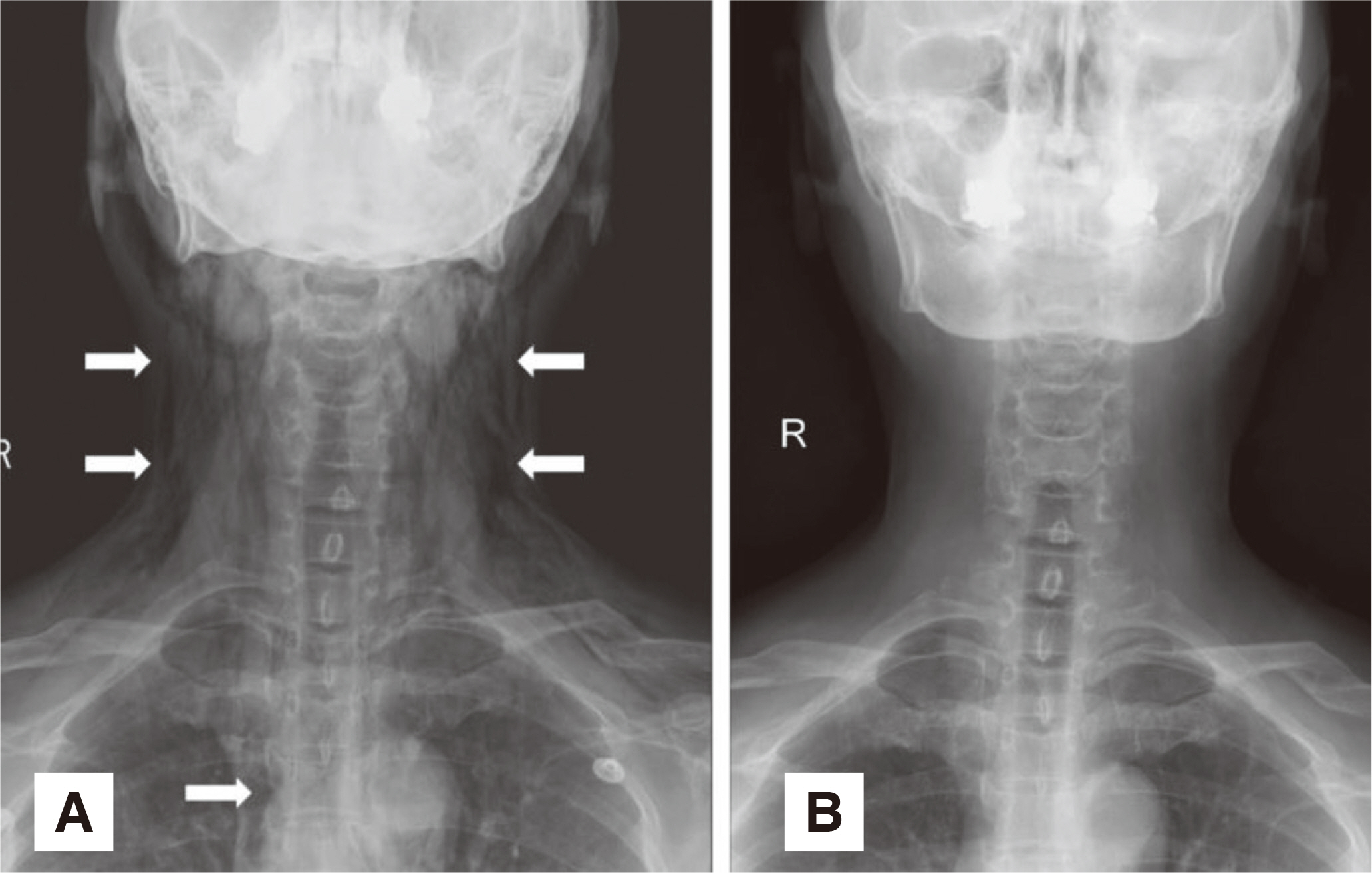J Dent Rehabil Appl Sci.
2021 Sep;37(3):171-176. 10.14368/jdras.2021.37.3.171.
Syncope and pneumomediastinum during the maxillary sinus elevation with an air-syringe: a case report
- Affiliations
-
- 1Department of Thoracic and Cardiovascular Surgery, Jeju National Hospital, Jeju National School of Medicine, Jeju, Republic of Korea
- 2Department of Dentistry, Jeju National Hospital, Jeju National School of Medicine, Jeju, Republic of Korea
- KMID: 2525991
- DOI: http://doi.org/10.14368/jdras.2021.37.3.171
Abstract
- Pneumomediastinum is a very rare and potentially catastrophic complication of dental procedures. Its common causes are tooth extraction, endodontic treatment, and subgingival curettage using handpieces and high-pressure air/water syringes. We present a case of massive pneumomediastinum with subcutaneous emphysema in a 61-year-old female who underwent bone grafting into the maxilla for pretreatment of dental implantation using a syringe. The patient suffered from abrupt severe odynophagia and loss of consciousness. The patient transferred to emergency department and images work-up revealed a pneumomediastinum and subcutaneous emphysema on the entire face and neck. We performed conservative treatments including prophylactic antibiotics, oxygen inhalation, and fasting meals, and then discharge after 7 days uneventfully. The patient’s syncope might be resulting from hypotension and pain shock induced by pneumomediastinum with a sudden chest compression. The pneumomediastinum could be resulting from concurrent perforation and massive air infiltration into the maxillary sinus during bone grafting. We suggest that pneumomediastinum needs prompt diagnosis and management because of the risk of airway obstruction when a patient present syncope in the dental room.
Keyword
Figure
Reference
-
References
1. Rawlinson RD, Negmadjanov U, Rubay D, Ohanisian L, Waxman J. 2019; Pneumomediastinum After Dental Filling: A Rare Case Presentation. Cureus. 11:e5593. DOI: 10.7759/cureus.5593. PMID: 31700706. PMCID: PMC6822872.2. Reed KL. 2010; Basic management of medical emergencies: recognizing a patient's distress. J Am Dent Assoc. 141 Suppl 1:20S–4S. DOI: 10.14219/jada.archive.2010.0349. PMID: 20436086.3. Grapatsas K, Tsilogianni Z, Leivaditis V, Kotoulas S, Kotoulas C, Koletsis E, Iliadis IS, Dahm M, Trakada G, Veletza L, Kallianos A, Huang H, Kosmidis C, Karanikas M, Thomaidis V, Porpodis K, Zarogoulidis P. 2017; Hamman's syndrome (spontaneous pneumomediastinum presenting as subcutaneous emphysema): A rare case of the emergency department and review of the literature. Respir Med Case Rep. 23:63–5. DOI: 10.1016/j.rmcr.2017.12.004. PMID: 29276676. PMCID: PMC5730040.4. Rose WD, Veach JS, Tehranzdeh J. 1984; Spontaneous pneumomediastinum as a cause of neck pain, dysphagia, and chest pain. Arch Intern Med. 144:392–3. DOI: 10.1001/archinte.1984.00350140222030. PMID: 6696577.5. Starch-Jensen T, Jensen JD. 2017; Maxillary Sinus Floor Augmentation: a Review of Selected Treatment Modalities. J Oral Maxillofac Res. 8:e3. DOI: 10.5037/jomr.2017.8303. PMID: 29142655. PMCID: PMC5676313.6. Muronoi M, Xu H, Shimizu Y, Ooya K. 2003; Simplified procedure for augmentation of the sinus floor using a haemostatic nasal balloon. Br J Oral Maxillofac Surg. 41:120–1. DOI: 10.1016/S0266-4356(03)00040-8. PMID: 12694707.7. Kfir E, Kfir V, Mijiritsky E, Rafaeloff R, Kaluski E. 2006; Minimally invasive antral membrane balloon elevation followed by maxillary bone augmentation and implant fixation. J Oral Implantol. 32:26–33. DOI: 10.1563/782.1. PMID: 16526579.8. Hussein LA, Hassan TAL. 2017; The Effectiveness of Oxidized Regenerated Cellulose as a Graft Material in Transalveolar Osteotome Sinus Lift Procedure. J Craniofac Surg. 28:1766–71. DOI: 10.1097/SCS.0000000000003943. PMID: 28891903.9. Abolnik I, Lossos IS, Breuer R. 1991; Spontaneous pneumomediastinum. A report of 25 cases. Chest. 100:93–5. DOI: 10.1378/chest.100.1.93. PMID: 1824034.10. Goh BK, Yeo AW. 2005; Traumatic pneumorrhachis. J Trauma. 58:875–9. DOI: 10.1097/01.TA.0000158249.77176.9A. PMID: 15824674.11. Caceres M, Ali SZ, Braud R, Weiman D, Garrett HE Jr. 2008; Spontaneous pneumomediastinum: a comparative study and review of the literature. Ann Thorac Surg. 86:962–6. DOI: 10.1016/j.athoracsur.2008.04.067. PMID: 18721592.12. Sahni S, Verma S, Grullon J, Esquire A, Patel P, Talwar A. 2013; Spontaneous pneumomediastinum: time for consensus. N Am J Med Sci. 5:460–4. DOI: 10.4103/1947-2714.117296. PMID: 24083220. PMCID: PMC3784922.13. Maunder RJ, Pierson DJ, Hudson LD. 1984; Subcutaneous and mediastinal emphysema. Pathophysiology, diagnosis, and management. Arch Intern Med. 144:1447–53. DOI: 10.1001/archinte.1984.00350190143024. PMID: 6375617.14. Feldtman RW, Oram-Smith JC, Manning LG, Buckley CJ. 1980; Spontaneous mediastinal emphysema. J Pediatr Surg. 15:648–50. DOI: 10.1016/S0022-3468(80)80517-3. PMID: 7441458.
- Full Text Links
- Actions
-
Cited
- CITED
-
- Close
- Share
- Similar articles
-
- A case of carotid sinus syncope due to maxillary neoplasm combined with vasovagal syncope
- Carotid Sinus Syncope in an Elderly Patient With Unexplained Syncope
- Implant Surgery with Both Sinus Bone Graft in the Maxillary edentulous patient: A Case Report
- Asymptomatic pneumomediastinum resulting from air in the epidural space: a case report
- A case of swallow syncope with sinus pause and vasovagal syncope





